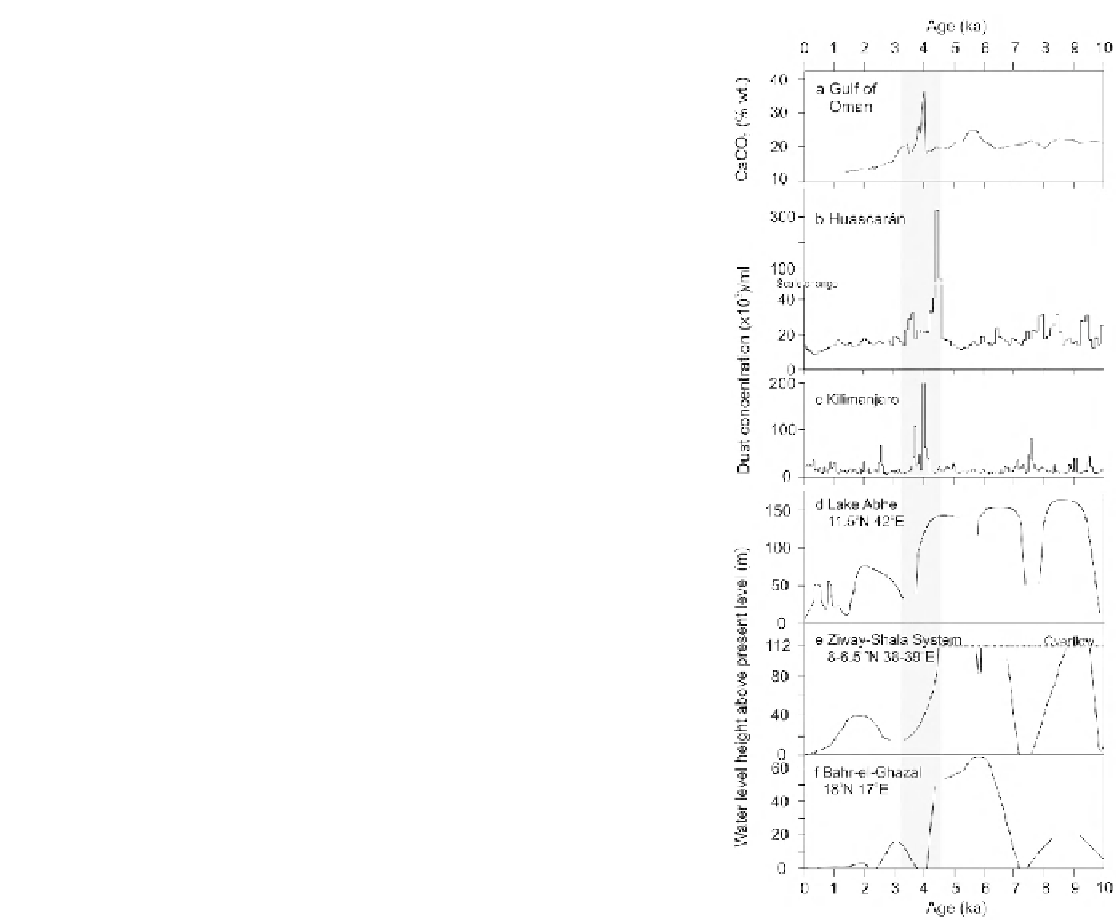Geoscience Reference
In-Depth Information
3112 before the Common Era (B.C.E.), and two Hindu
calendars began in 3102 and 3116 B.C.E. The Mesoamerican
(often called Mayan) long-count calendar in particular has
received some attention in the popular media lately as the
alleged
“
end date
”
of the current cycle in the calendar (2012
Common Era (C.E.)) draws near. So far, however, there
appears to be little evidence that the development of this
calendar had much to do with an anomalous climate event,
although there are indications of drought across Mesoamer-
ica ~5800 years B.P. [Voorhies and Metcalfe, 2007]. Before
the onset of the middle Holocene climatic transition, there is
evidence of declining human occupation in the Atacama
region, Chile (
) (Figure 2), which
recovered as more humid conditions dominated [Grosjean et
al., 1997; Núñez et al., 2002]. Uncertainties about societal
collapse and abrupt climate change are directly linked to
uncertainties in the dates of past events in both the paleocli-
matic and archaeological records. The ability of societies to
adapt to abrupt climate change may, more often than not, be
linked to a nexus of social, political, and climate events that
force the society across a threshold.
“
Silencio Arqueológico
”
2.2. The Abrupt Arid Event of 4200 Years B.P.
A substantial collection of proxy climate records from
around the tropics (Figure 3) provides evidence for another
widespread abrupt climatic reversal that occurred approxi-
mately one millennium after the middle Holocene cold event.
This particular episode, which appears in the records around
4.0 to 4.5 ka B.P., apparently extended from South America to
northern Africa to eastern China and was more a result of
extreme decrease in effective moisture than of temperature
changes. Evidence appears in a marine core from the Gulf of
Oman [Cullen et al., 2000] (Figure 3a), in which an abrupt
spike in carbonates has been chemically traced to an arche-
ological site (Tell Leilan) in Syria, the home of the ancient
Akkadian culture [Weiss et al., 1993]. Two ice core records
from opposite sides of the world, Nevado Huascar
Figure 3.
Comparisons of (a) the Gulf of Oman middle Holocene
carbonate record on a calibrated
14
C time scale (modified from
Cullen et al. [2000]); (b) the Huascar
á
n Holocene dust record [from
Davis and Thompson, 2006], reprinted from the Annals of Glaciol-
ogy with permission of the International Glaciological Society; and
(c) the dust from the Kilimanjaro ice core, modified from Thompson
et al. [2002]. Tropical African Holocene lake level records from
(d) Lake Abhe [from Gasse, 1977], reprinted with permission; (e)
Ziway-Shala System [from Gillespie et al., 1983], reprinted with
permission; and (f) Bahr-el-Ghazal [from Servant and Servant-
Vildary, 1980], reprinted with permission. The gray bar marks the
middle Holocene arid period in the records.
in in the
Cordillera Blanca of northern Peru and Kilimanjaro in Tan-
zania (Figure 1), exhibit significant spikes in insoluble dust
that occur during this period. The high-resolution Huascar
á
n
dust record, which extends to the end of the last glacial stage,
contains a large dust peak at ~4.2 to 4.5 ka B.P. (Figure 3b),
which is the most prominent feature in the Holocene [Thomp-
son, 2000]. The dust that is blown off the African west coast
during austral summer (the wet season in the Cordillera
Blanca) is entrained by the northeast trade winds and carried,
along with moisture, across the tropical North Atlantic and
the Amazon Basin. Saharan dust transported during the aus-
tral summer has been found in the Amazon Basin [Swap et al.,
1992]. The dust that was deposited on Huascar
á
middle Holocene was most likely transported in this manner
during centuries of extreme aridity both in Africa and South
America [Davis and Thompson, 2006]. The large dust spike
á
n during the









Search WWH ::

Custom Search